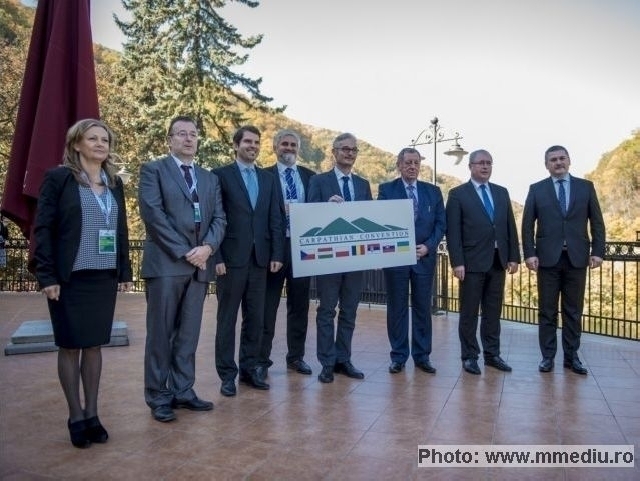The protection of forests in the Carpathian region
The Carpathian Convention meets in Hungary to discuss the protection of the Carpathian regions.

România Internațional, 27.10.2017, 12:59
The Carpathian Mountains, which stretch over 8 countries and 1,500 km, are Europes second largest mountain chain after the Alps. These mountains have a unique natural richness of a high biological value being home to numerous endangered species and the largest virgin forests in Europe. It is estimated that there are 300,000 hectares of quasi-virgin forests in these mountains, which is only a small part of the woods that once covered Europe. These include over 10,000 hectares of beech forests in eastern Slovakia and western Ukraine, which are part of UNESCOs heritage list, as well as some of the few still intact forests in Europe to be found in the southern part of the Romanian Carpathians. Over 24,000 hectares of beech forests from Romania have this year been added to UNESCOs World Heritage Sites.
However, the Carpathians continue to be at threat as a result of human intervention, including the fragmentation of habitats, the disappearance of various species of plants and animals and the destruction of mountain rivers. For this reason, 14 years ago, the Carpathian countries decided to join efforts for the sustainable protection and development of the Carpathians by laying the foundations of the Carpathian Convention.
In mid-October, Hungary hosted the fifth conference of this convention, which was also attended by Alina Szasz, public manager with the Brasov County Council:
“Romania ratified the Carpathian Convention in 2006. This is an agreement between the countries crossed by the Carpathians, namely Ukraine, the Czech Republic, Slovakia, Hungary, Serbia, Poland and Romania, and its aim is to view the Carpathians as a single entity, without rivalries and borders. The Convention aims to ensure the management of cultural and natural resources and the creation of new jobs, always taking into account the people living in these regions. The Convention itself consists of 8 working groups: the sustainable preservation of biodiversity, regional development, agriculture and rural development, durable forestry management, industry, transport, infrastructure, sustainable tourism, culture and traditions and adjustment to climate change. Besides these 8 working groups, the Convention runs four additional protocols, namely for the sustainable usage and preservation of biodiversity, for sustainable forestry management, for sustainable tourism and transportation. The meetings, which take place every three years, discuss each protocol and article of the convention, as well as the positive aspects and the efforts made so far and that needs to be done in the future. Every country presents its efforts in the respective areas.”
Starting this year, Romania will be hosting the Centre of Cooperation Platform for Sustainable Tourism within the Carpathian Convention, the first at national level and the third regional one, after the ones in Ukraine and Poland. A series of activities making use of the huge potential of the Carpathians will unfold here. All involved actors in the tourist sector will also try to identify the best ways of cooperation, particularly those who carry out their activity in mountainous areas. Alina Szasz explains:
“We have presented in Lillafuered, Hungary, a programme that we have designed for the 2017-2020 timeframe. The programme has five major goals, including the management of a database that is constantly uploaded with the projects that have been developed or implemented in the Carpathians, as well as the existing financing sources. This way, all Territorial Administrative Units and NGOs in Romania, or those from across the Carpathian chain, have access to information about the projects that have been carried out in these mountainous regions, precisely to avoid running the same projects again and also to set examples of best practice. Apart from these five main goals, we have chosen 15 of the 27 activities included in the country action plan and 9 of the 24 activities included in the joint action plan of the signatory countries. These two action plans (the country plan and the joint plan of the signatory countries) are actually at the core of the sustainable tourism strategy. This strategy provides the framework and the actions that should be implemented across the Carpathian chain. Every country should establish what exactly it wants to achieve and what it really needs, depending on its level of development. Thus, we want to achieve a harmonious development.”
The green watchdog WWF Romania has contributed various projects to the implementation of the Carpathian Convention, says Cristian Pap, WWF regional coordinator for protected areas:
“We have implemented a project in the whole Carpathian eco-region, and have debated the issue of the sustainable use of natural resources. It refers to forests, all sorts of species of plants and animals, and waters. We are now carrying out a project to ensure the sustainable development of infrastructure at the Carpathians level. Our strategic partners in the project are the Environment Ministry and the Transport Ministry and we want to have, for instance, properly built highways, which pay attention to wildlife corridors and do not disrupt the movement of large animals to areas with a rich biodiversity. We refer to ecoducts and to those measures aimed at reducing the impact of highways or roads on the movement of big carnivores. In another move, huge steps have been taken to identify and protect primeval forests. We have also taken action in the field of climate change. Two weeks ago, in Hungary, for instance, a new form of the Convention was adopted, and it includes a new article that recognises how vulnerable the Carpathians are to climate change. According to this article, the signatories should implement actions meant to cushion the effects of climate change, for instance to reduce greenhouse gas emissions. The sides should also take measures of adaptation to climate change, whose effects are becoming visible.”
Representatives of the seven countries who attended the meeting hosted by Hungary have arrived at the conclusion that cooperation is further needed to cope with the new challenges in the Carpathian region. The sixth Conference of the Parties of the Carpathian Convention is due in Poland, in 2020.






























